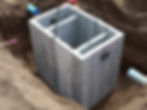.jpg)

.png)
Experienced, reliable specialist waste removal
Clanville Draintech is a local leader in grease and oil disposal. We offer:
Regulatory compliance
Service reliability
Experience and expertise
GREASE TRAP & OIL INTERCEPTOR EMPTYING
GREASE TRAP & OIL INTERCEPTOR EMPTYING
What to look for in a grease and oil disposal specialist?
It's essential to use a grease trap and oil interceptor emptying specialist due to their expertise in efficient cleaning techniques, regulatory compliance knowledge, and ability to prevent issues through regular maintenance. Clanville Draintech can offer reassurance through references, certifications, transparent pricing, service agreements, environmental responsibility, and emergency support. Our experience and commitment ensures proper system functionality, legal compliance, and peace of mind for businesses.

Some other ways Clanville Draintech can help

Grease trap and oil interceptor emptying involve a series of steps to ensure the effective removal of accumulated fats, oils, and debris:
1. Assessment: Specialists assess the condition and size of the grease trap or oil interceptor to determine the frequency of cleaning needed. This assessment helps tailor the cleaning schedule to your facility's requirements.
2. Preparation: Before emptying, the specialist may recommend minimizing water usage to reduce the level of waste in the trap or interceptor. This helps ensure efficient and thorough cleaning.
3. Waste Removal: The specialist pumps out the contents of the grease trap or oil interceptor using specialized equipment. This equipment is designed to handle the specific waste materials and prevent spills or contamination.
4. Scraping and Cleaning: Once emptied, the interior of the trap or interceptor is thoroughly scraped and cleaned. This process removes residual grease and debris that might have adhered to the walls and surfaces.
5. Inspection: During cleaning, the specialist inspects the trap or interceptor for any signs of damage or wear. Identifying potential issues allows for timely repairs, preventing future problems.
6. Disposal: The collected waste is transported to authorized facilities for proper disposal, adhering to environmental regulations. Reputable specialists provide documentation of waste disposal for compliance records.
7. Maintenance Advice: Specialists may offer recommendations for preventive maintenance practices to extend the interval between cleanings and ensure optimal trap or interceptor performance.
8. Documentation: A comprehensive report is often provided, detailing the work performed, waste disposed of, and any recommendations for future maintenance. This documentation helps with regulatory compliance and maintaining records.
9. Scheduling Next Service: Depending on the usage of your facility and the size of the trap or interceptor, specialists may recommend a future cleaning schedule to prevent buildup and maintain efficient operation.
Overall, grease trap and oil interceptor emptying is a meticulous process involving assessment, waste removal, thorough cleaning, inspection, and proper waste disposal. Regular emptying by professionals helps prevent blockages, maintain system functionality, and comply with environmental regulations.
What's involved in grease trap and oil interceptor emptying?
Everything you need to know about wet waste disposal
Here we answer some common questions to do with drainage issues.

.png)
_edited.jpg)


